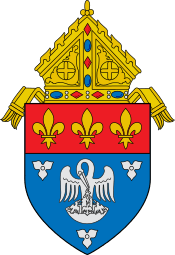Loyola University New Orleans
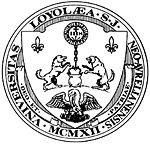 | |
| Latin: Universitas Loyolaae Neo Aurelianensis | |
Former names |
Loyola College (1886–1912) Loyola University (1912–1996) |
|---|---|
| Motto |
Deo et Patriae (Latin) Ad Majorem Dei Gloriam (Latin) |
Motto in English |
For God and country For the Greater Glory of God |
| Type |
Private Nonprofit Research Coeducational |
| Established |
Founded 1904 Chartered July 10, 1912 |
| Affiliation | Roman Catholic (Jesuit) |
| Endowment | US $266.2 million[1] |
| President | Rev. Kevin Wm. Wildes, S.J. |
Administrative staff | 240 |
| Students | 5,008[2] |
| Undergraduates | 3,165 |
| Postgraduates | 1,843 |
| Location |
New Orleans, Louisiana, United States 29°56′03″N 90°07′18″W / 29.934236°N 90.121685°WCoordinates: 29°56′03″N 90°07′18″W / 29.934236°N 90.121685°W |
| Campus |
Total: 23 acres (9.3 ha) Main campus:19 acres (7.7 ha) Broadway campus:4 acres (1.6 ha) |
| Fight song | "Loyola Fight Song" |
| Colors | Maroon and gold |
| Athletics | NAIA Division I – SSAC |
| Sports |
10 varsity sports teams[3] (5 men's and 5 women's) |
| Nickname | Wolfpack |
| Affiliations |
AJCU ACCU NAICU CIC |
| Website | www.loyno.edu |
 | |
Loyola University New Orleans is a private, co-educational, and Jesuit university located in New Orleans, Louisiana. Originally established as Loyola College in 1904, the institution was chartered as a university in 1912. It bears the name of the Jesuit patron, Saint Ignatius of Loyola. Loyola is one of 28 member institutions that make up the Association of Jesuit Colleges and Universities and, with its current enrollment of approximately 5000 students, is among the larger Jesuit universities in the southern United States. Loyola University New Orleans is ranked as the tenth best institution among Southern regional universities offering masters and undergraduate degrees in the 2017 issue of the annual America's Best Colleges issue and guidebook published by U.S. News & World Report.[4] The Princeton Review also features Loyola University New Orleans in the most recent editions of its annual book, The Best 371 Colleges.[5] In the past, the school has been called Loyola of the South, Loyola New Orleans, Loyola University, New Orleans, and Loyola University of New Orleans.[6]
History
Founding
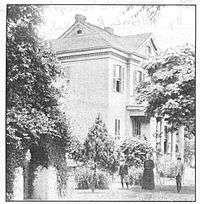
In the early 18th century Jesuits first arrived among the earliest settlers in New Orleans and Louisiana.[7]
Loyola University in New Orleans was founded by the Society of Jesus in 1904 as Loyola College on a section of the Foucher Plantation bought by the Jesuits in 1886. A young Jesuit, Fr. Albert Biever, was given a nickel for street car fare and told by his Jesuit superiors to travel Uptown on the St. Charles Streetcar and found a university.[8] As with many Jesuit schools, it contained both a college and preparatory academy. The first classes of Loyola College were held in a residence behind Most Holy Name of Jesus Church. Fr. Biever was the first president. The first of Loyola's permanent buildings was undertaken in 1907, with Marquette Hall completed in 1910.
In 1911, the Jesuit schools in New Orleans were reorganized. The College of the Immaculate Conception, founded in 1847 in downtown New Orleans, split its high school and college divisions and became solely a secondary institution, now known as Jesuit High School. Loyola was designated as the collegiate institution and was chartered as Loyola University on July 10, 1912.[9]
Growth
Loyola grew steadily over the years on its uptown campus. By the end of its first decade, the university not only included the College of Arts and Sciences, but also a School of Law (1914), a School of Dentistry (1914), and a College of Pharmacy (1919).
Several years later, a School of Music was added to the growing curriculum.[9] At the time, the university's campus consisted mainly of Marquette and Bobet Halls, with large athletic fields extending back towards the end of the campus at Freret St. Loyola has the distinction of transmitting the first radio broadcast in the Deep South, when WWL began operation as a laboratory experiment on March 31, 1922.[10]
With the discontinuance of the football program in the 1930s, more space became available for construction of new facilities. Stallings Hall, built as a dedicated building for the College Of Business Administration, and the Memorial Library (now known as the "Old Library")[11] were constructed in the post World War II years, accommodating the growth of the student population.
Norman Francis entered the Law School in 1952, becoming the first African-American admitted to the university.[12]
More expansion continued in 1964, with the addition of the Joseph A. Danna Student Center; Albert Biever Hall, a student residence hall named after the first university president; and a central heating/cooling plant. Built soon after in 1967 was Henrietta Buddig Hall, a student residence that is Loyola's tallest building at twelve stories. The last building to be added in the 1960s was the J. Edgar Monroe Science Building (now known as Monroe Hall), the largest academic building erected to date.
The College of Pharmacy closed in 1965. The School of Dentistry closed in 1970.
During the 1970s, Loyola began to make many changes, especially regarding Jesuit governance and in the academic curriculum, reflective of many universities during the same period. Reflecting the precedent for reform established by Vatican II, governance of the university shifted from a Jesuit regulated Board of Regents to a combined lay and clerical Board of Trustees. During this period, the Common Curriculum was developed to give students a wide breadth of knowledge in certain core areas, including Science, Math, History, and English studies. A broader trend was seen in the growth of the university during this period, seeing it gradually transform from a regional, largely commuter college to a higher national profile school that attracted students from across the United States.
In 1984 Loyola purchased the facilities of St. Mary’s Dominican College, a nearby Catholic women's college which was closing down, and transformed it into the Broadway campus (after the name of its street location). Today, the Broadway campus includes Loyola's School of Law, Cabra Residence Hall, and a Department of Visual Arts.
Expansion in recent years has seen the addition of Mercy Hall, purchased in 1993, a former girl's preparatory academy; construction of Carrollton Hall, an upperclassman residence; and the J. Edgar and Louise S. Monroe Library, the latter two completed in 1999.
In 1996, the Association of Jesuit Colleges and Universities granted exclusive branding rights to Loyola University Chicago to call itself Loyola University. This resulted in Loyola New Orleans' current trademark, Loyola University New Orleans.[13]
Hurricane Katrina and aftermath
In August 2005, Loyola closed its campus and evacuated its students in anticipation of Hurricane Katrina. The campus sustained minimal wind damage including broken windows but floodwaters did not breach any buildings. Due to the devastation of the city of New Orleans, Loyola canceled classes for the fall 2005 semester. Following cleanup, classes resumed with the start of the spring 2006 semester on Monday, January 9, 2006. Despite the displacement of the entire student body during the fall 2005 semester, 91 percent of Loyola’s undergraduate students returned for the spring 2006 semester.[14] Loyola held commencement ceremonies for the Class of 2006 on April 28–29, becoming the first New Orleans college to do so post-Katrina.
On April 10, 2006, President Kevin Wm. Wildes, S.J. unveiled Pathways - Toward Our Second Century, Loyola's strategic post-Katrina plan. The plan restructured the University's colleges and eliminated several academic programs and faculty positions to reduce operating costs and revitalize the University. The Board of Trustees unanimously approved and passed the plan on May 19, 2006. In response, the faculty of the College of Arts and Sciences produced a vote of no-confidence in both President Wildes and Provost Walter Harris.[15] In fall 2006, Loyola welcomed the class of 2010, the first post-Katrina freshman class, with 555 new students.[16] Since the storm, Loyola has completed all physical repairs that were caused by the hurricane; and its enrollment is on a steady rise to pre-Katrina numbers.[17][18]
The student-run online news service, Pack News, was established in 2012. Pack News marks the return of video-based journalism since the broadcast program was eliminated in 2007 with the university-wide Pathways elimination program after Hurricane Katrina.
Local chapters of the Alpha Delta Gamma fraternity, which opened in 1932, and the Sigma Phi Epsilon fraternity, which opened in 1983, were closed during 2012.
There have been seventeen presidents since the establishment of Loyola College in 1904,[19] including Michael F. Kennelly, S.J. (1970–1974), William J. Byron, S.J. (2003-2004 (acting)), and Kevin Wm. Wildes, S.J. (2004–present).
|
University seal
The seal, which was adopted by the university in 1929, features the coat of arms of the house of Loyola with the emblem of the Society of Jesus at the top. Central to the seal are two wolves and a golden pot, which come from St. Ignatius Loyola's family crest and symbolize generosity (having enough to give to the wolves.) Above the figures of the wolves appears the fleur-de-lis, which represents the French origin of New Orleans and Louisiana. Beneath it is a pelican feeding its young with her own blood; this ancient symbol of Christianity (Christ feeding the Church with his body and blood through the Eucharist) depicts Loyola as an institution of the state of Louisiana.[21]
Academics
| University rankings | |
|---|---|
| National | |
| Forbes[22] | 550 |
| Regional | |
| U.S. News & World Report[23] | 10 (South) |
| Master's University class | |
| Washington Monthly[24] | 70 |
Profile
The university enrolls 5,000 students, including 3,000 undergraduates. The student to faculty ratio is 11 to 1. The Princeton Review features Loyola New Orleans in the 2010 edition of its annual book, The Best 371 Colleges.[5] Loyola University New Orleans ranks 10th of the South regional universities in 2017 U.S. News & World Report Best College Ranking.[25] The New York-based education services company says Loyola New Orleans offers students an outstanding undergraduate education.[26]
Nearly all classes are taught by full-time faculty, 91 percent of whom hold doctoral or equivalent degrees in their areas of expertise. Loyola professors have been recognized nationally and internationally by the Pulitzer Committee, the National Science Foundation, the National Endowment for the Humanities, and by numerous other associations.[27]
Colleges
Loyola is organized into colleges specializing in the liberal arts, social and physical sciences and certain professions. The colleges at Loyola include:
- College of Humanities and Natural Sciences
- College of Social Sciences
- The Joseph A. Butt, S.J., College of Business
- College of Music and Fine Arts
- College of Law[28]
College of Arts and Sciences
The College of Arts and Sciences focuses on areas concerning the natural sciences and liberal arts programs. It contains the departments of English, history, languages, philosophy, religious studies, psychology, biology, liberal studies, chemistry, mathematics, and physics. Also under the college's supervision is the Loyola Institute for Ministry (LIM).[29] Students have been awarded British Marshall, Fulbright, Goldwater, Mellon, Mitchell, and Rhodes scholarships, and have been included as USA Today's top students.
College of Social Sciences
The College of Social Sciences specializes in areas that deal with the human condition. The College of Social Sciences contains the departments of counseling, criminal justice, human and organizational development, sociology, and political science. The college also includes the Schools of Nursing and Mass Communication.[30] The School of Mass Communication houses award winning programs in public relations, journalism and advertising.[31] This includes the Loyola Bateman team which won the 1997, 2000, 2003, 2005 and 2008 national competitions sponsored by the Public Relations Student Society of America.[32]
Joseph A. Butt, S.J., College of Business
The College of Business began as an outgrowth of the College of Arts and Sciences and became a full-fledged college in 1947. In 1983, the College of Business was renamed in honor of Joseph A. Butt, S.J., a longtime Jesuit professor in the business college. The College of Business is accredited by the Association to Advance Collegiate Schools of Business (AACSB), a prestigious honor awarded to only 450 business schools worldwide. The college offers programs in the fields of economics, finance, international business, management, marketing, accounting and the business of music.[33]
College of Music and Fine Arts
The College of Music was established when the New Orleans Conservatory of Music and Dramatic Art, which was founded by Ernest Schuyten in 1919, was incorporated into the university in 1932. The College of Music gives students the chance to combine liberal arts with professional music courses. It is the only Jesuit college of music in the United States. The college offers programs in Jazz Studies, Music Education, Music Therapy, Music Industry Studies, Instrumental Performance, Vocal Performance, Ballet, Theatre Arts, and Visual Arts. In April 2007, the Thelonious Monk Institute of Jazz Performance announced its relocation to the College of Music and Fine Arts from the campus of the University of Southern California. The Music Industry program was one of the first in the country, and combines both the performing and technical aspects of the music business.[34] The Princeton Review called it the "second best program in the nation" for music business.
College of Law
Loyola's law school opened in 1914. Co-located for many years on the main campus of Loyola, the Law School moved to the new Broadway campus in 1986, after Loyola purchased the closed campus of St. Mary’s Dominican College in 1984. The School of Law was renamed the College of Law with the passage of the PATHWAYS Plan on May 19, 2006.[35]
Centers and institutes
The University houses institutes in many different disciplines:
- Twomey Center for Peace Through Justice
- Jesuit Social Research Institute (JSRI)
- Thelonious Monk Institute of Jazz Performance
- Center for Environmental Communications
- Center for the Study of Catholics in the South
- Gillis Long Poverty Law Center
- Jesuit Center
- Lindy Boggs National Center for Community Literacy
- Loyola Institute of Politics
- Loyola Institute for Ministry (LIM)
- Shawn M. Donnelley Center for Nonprofit Communications[36]
Campus
Loyola is located in the historic Audubon Park District on St. Charles Avenue. Its original campus, now called the Main Campus, was founded on a tract of land purchased by the New Orleans Jesuits in 1889. The purchased portion of land was much larger than the current day campus; in fact, the original land purchase contained the land now occupied by both Loyola and Tulane universities and Audubon Place.[37] Through the next twenty years, portions of the original land purchase were sold to different entities to raise money for the new university, resulting in the current Main Campus area of 19 acres.
By the 1950s, most of the original campus had been developed and the university looked around for areas where it could expand. In the 1960s, J. Edgar Monroe, a major benefactor of the university, donated to Loyola a large undeveloped tract of land in Metairie where the university could either expand or move its entire location. After reviewing its options, including the sale of the original campus to Tulane University, the university decided to remain on St. Charles Avenue, subsequently selling off its property in Metairie in ten years as a condition of the donation.
The Louis J. Roussel, Jr., Performance Hall on the Loyola campus, which stages symphony concerts, is named for the late New Orleans businessman Louis J. Roussel, Jr.
The closure of St. Mary's Dominican College in 1984 provided an opportunity for Loyola to expand its campus. After renovation of the closed college and some new construction, the Broadway Campus was opened in 1986, with several university offices and programs, the school of law most significantly, moving to the new campus.
Main Campus
Loyola's first campus, the Main Campus is located on St. Charles Avenue across from Audubon Park and adjacent to Tulane University, which also fronts St. Charles. The St. Charles Streetcar passes in front of the main campus. According to The Princeton Review Loyola students get along well with members of the local community. It is ranked #11 out of 371 Best Colleges for Great Town-Gown Relations.
The Main Campus contains the majority of the undergraduate academic divisions on campus, as well as serves as the hub of campus activities. Fronting St. Charles is Marquette Hall, the oldest campus building, which serves as the iconic image of the university. Several quadrangles organize the campus proceeding from the front of campus to its northern border at Freret Street, including the Academic quad, the Plaza De Los Martires De La Paz, or Peace Quad, named after the Salvadoran martyrs of 1989,[38] and the Residential Quad. Other notable buildings include the Joseph Danna Student Center, J. Edgar and Louise S. Monroe Library, Bobet Hall, J. Edgar Monroe Hall, the Music and Communications Building, and Branch Knox Miller Hall.
Marquette Hall
Named after the Jesuit explorer Fr. Jacques Marquette, S.J., Marquette Hall is one of the most prominent buildings on campus. Begun in 1907, it was finished in 1910. After its completion, most of the classes of the college and later, the university were conducted in the building until the construction of Bobet Hall in the late 1920s. The university's first library, the Bobet Library, was located on the third floor of Marquette Hall until the Memorial Library was constructed in the 1950s. When the dentistry school began its operations, the fourth floor of Marquette was used partly as a cadaver dissection area, and an external winch was used to hoist the cadavers up the four floors.[11] Today, Marquette primarily functions as an administrative building, but some classes are still conducted there. Also, the main theatre used by the Theatre Arts program is housed on the third floor of the building.[39]
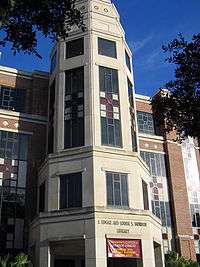
J. Edgar and Louise S. Monroe Library
The J. Edgar and Louise S. Monroe library is the main university library, constructed in 1999, replacing the Memorial Library built in 1950. The 150,000-square-foot (14,000 m2) library includes 377,000 books and periodicals and online access to 36,000 journals and 27,000 e-books.[40][41] Its music collection includes over 20,000 scores and recordings, and the special collections and archives include material concerning Jesuits in New Orleans and the U.S. South.[41] The library has won numerous awards in its existence, including the Association of College & Research Libraries’ 2003 "Excellence in Academic Libraries Award and the 2004 H.W. Wilson Award for Professional Development. More so, the library ranks 5th in the “Best College Library” category of The Princeton Review's 2010 edition of The Best 361 Colleges.[42][43]
Weekend uses of campus
In previous years the Japanese Weekend School of New Orleans (ニューオリンズ日本語補習校 Nyū Orinzu Nihongo Hoshūkō), a Weekend Japanese school program, held its classes at Loyola University's main campus. Kindergarten and elementary school students used Monroe Hall and Junior high school students used Marquette Hall.[44]
Broadway Campus

The former campus of St. Mary's Dominican College, the 4-acre (16,000 m2) site was purchased by Loyola in 1984. Broadway Street forms its downtown border, and fronts St. Charles Avenue. The campus is located in the Greenville neighborhood, a former plantation and town annexed by New Orleans in the 19th Century. Greenville Hall, a Registered Historic Place built in 1889, forms the focus of the small campus, along with the College of Law building.[45]
Law Library
Loyola University New Orleans' Law Library is located in the College of Law building on the Broadway Campus. It contains over 286,000 volumes and microfilm for the support of the students and faculty of the College of Law. Due to the unique tradition of civil law in Louisiana, the library has substantial collections from civil law jurisdictions from around the world, including France, Scotland, and Quebec.[46]
Sustainability
Loyola's Statement on Environmental Responsibility details the ways in which campus operations strives to maintain its facilities in an environmentally sound and sustainable manner. Currently, 75% of all university classrooms are equipped with motion sensor lights and irrigation systems are designed with rain sensors to conserve water, both efforts supporting energy efficiency. The Loyola recycling program includes office paper, aluminum cans, and newspaper.[47]
The student-run group Loyola University Community Action Program organizes the Environmental Action Program, which works to educate & advocate for environmental justice on campus and in the Gulf Coast region.[48] The Student Government Association maintains a Sustainability Garden to provide the campus community with gardening space and supplies as well as sustainability information.[49]
Student life
Danna Student Center
The epicenter of Loyola's on-campus life is the Dr. Joseph A. Danna Center, built in 1964. The Danna Student Center houses many services, including the campus bookstore, lounges, and student organization and university offices, and all of the university's dining services. Loyola's main cafeteria, the Orleans Room (colloquially known as the "O.R.") is also housed in the building. In 2008, the university completed a US$3 million renovation of the Danna Student Center under the guidance of Henry R. Muñoz III, improving the organization and services of the building.[50]
Student housing
The university requires all students from outside the metropolitan New Orleans area to live on campus their first two years. Housing options include four on-campus residence halls for students: Biever Hall, Buddig Hall, Carrollton Hall, and Cabra Hall. Biever and Buddig hall are primarily reserved for freshmen and underclassmen male and female students, respectively. Carrollton and Cabra Halls are for upperclassmen students, offering suite and apartment-style living. The Department of Residential Life manages the Residence Halls, and provides programming aimed at building community within the residence halls. The Residence Hall Association, made up of residential students, serves as a representative for students to the administration and also allocates funding to student-run projects and activities.
University Sports Complex
The University Sports Complex, formerly called the Recreational Sports Complex or Rec Plex, houses all the athletic facilities on Loyola's campus. It was constructed in 1987 and paid for in full by Freeport-McMoRan. The complex is situated on the fifth and sixth floors of the Freret Street parking garage.
The Complex features many modern amenities, including a jogging track; indoor tennis, racquetball, and basketball courts; weight rooms; and a six-Lane, Olympic style swimming pool.
Organizations
Student government
The student body of Loyola is governed by a Student Government Association (SGA). The SGA is divided into three cohesive but independent branches—the Executive, Legislative, and Judicial.
The Executive branch is headed by the President, which consists of the Executive Staff: Chief of Staff, Director of Public Relations, Director of Finance, etc. The Chief of Staff organizes and maintains the hired staff and reports to the President. The Director of Finance (in lieu with the Vice President) helps run the Budget Allocations process for chartered student organizations. The Director of Public Relations handles all publicity and advertising associated with all three branches.
The Legislative branch is run and maintained by the Vice President, who oversees all members of Senate: the Senior Senator at Large, Junior Senators at Large, College Presidents, Senators, and First-year (new student) Student Senators. Members of Senate are divided up by the four colleges: College of Business, College of Humanities and Natural Sciences, College of Music and Fine Arts, College of Social Sciences.
The Judicial Branch is headed by the Chief Justice, which consists of the Court of Review: Clerk of Court and Justices of the Court. The Justices of the Court are appointed by an interview process with the President and serve two-year appointments. The Court meets weekly or bi-weekly to judge student cases.
Service organizations
The Loyola University Community Action Program (LUCAP) was founded in 1975 by a student group led by Loyola students Robert Guasco and Mary Baudouin as an organization connecting students with community service, social justice, and advocacy work in New Orleans and abroad. LUCAP is the largest student organization on campus, due largely to its inclusive membership of any current or former project volunteer. LUCAP partners with local non-profit organizations including Habitat for Humanity, Green Light New Orleans, and the Gulf Restoration Network to provide students with opportunities to serve in their community. LUCAP successfully organized against Freeport-McMoRan in 1995 after the company donated money to Loyola University New Orleans to found the Institute for Environmental Communications, build sports facilities, and support the Twomey Center for Peace Through Justice. The organization cited Freeport's history of lack of regard for environmental quality and its history of human rights violations in the developing world. LUCAP organized student protest led to Freeport requesting their donation be returned.[51] Other organizations include Circle K International, Big Brothers/Big Sisters, Peers Advocating Wellness (PAWS), and many others. Many students took a lead in rebuilding New Orleans after Hurricane Katrina through these service organizations.
Greek life
Loyola is home to 15 different social fraternities and sororities that encompass over 20 percent of the undergraduate population. Presently, none of the Greek organizations own official houses. Loyola's Greek organizations are governed by three councils, the Interfraternity Council, the Panhellenic Association, and the National Pan-Hellenic Council.[52]
|
|
Campus publications and media
The student-run weekly newspaper, The Maroon, was established in 1923. It is published weekly during the spring and fall semesters. The Maroon has been nominated for the Associated Collegiate Press' National Pacemaker Award 11 times and won the award in 1982, 1983, 1986, 1998, 1999, 2006, and 2015.[53][54][55] The Maroon is part of Loyola Student Media, the university student-media organization that publishes and sells advertising for The Maroon, The Maroon Online, Wolf Magazine, and Pack News.
Additional student publications include Wolf Magazine, Loyola's student-run magazine, which is part of Loyola Student Media. Wolf Magazine was once "The Wolf", the annual yearbook. Other student publications include ReVisions, the annual literary arts journal, Hyster, the Women's Issues Organization's zine, and Reader's Response, which publishes the single best paper from each of the English Department's literature and theory courses. Each semester, a small group of students intern for The New Orleans Review, an international journal of contemporary poetry, fiction, nonfiction, art, photography, film and book reviews, founded in 1968 .[56]
Crescent City Radio, is the university’s internet radio station based in New Orleans as a Freeform radio station. The station broadcasts a diverse offering of locally produced entertainment, music, and talk programs ranging from listener-requested music, local music talent, and radio formats such as urban contemporary, mainstream urban, adult contemporary, classical music, swamp pop, gospel, and Latin Top 40 Pop. The station is managed by the Music Industry Studies Program of the College of Music and Fine Arts at Loyola University New Orleans.
The student-run online news service, Pack News, posts weekly online video news and entertainment updates along with individual news reports, and commentary. Since 2013, Pack News has focused its weekly news updates to covering one specific topic in depth followed by political commentary. Topics have usually favored the political left and Democratic Party. Pack News is produced by the university’s Radio Television Digital News Association’s student chapter and is part of Loyola Student Media except in staff hiring.[57]
Athletics
Loyola–New Orleans teams are known as the Wolfpack. The university is a member of the National Association of Intercollegiate Athletics (NAIA), competing in the Southern States Athletic Conference (SSAC). The Wolfpack formerly competed in the Gulf Coast Athletic Conference (GCAC). Men's sports include baseball, basketball, cross country, tennis, track & field, and swimming; while women's sports include basketball, cross country, golf, tennis, track & field, volleyball, and swimming. [58]
Loyola's six intercollegiate teams are almost wholly funded through student activity fees per a student referendum passed in 1991. In 1972, Loyola suspended its athletics program, citing "educational and financial" reasons.[59] However, in 1991, the athletics program was re-instituted, amid student appeals for its reinstatement, including the aforementioned referendum. Since 2003, the athletic department has offered three athletic scholarships in basketball to attract talent. Locally, Loyola's biggest rival is the adjacent Tulane University, and the annual basketball game between the two teams is one of biggest athletic events at Loyola. Another rival in conference play is a fellow Jesuit university Spring Hill College. The Pack Pride Committee was founded in 2007 to promote athletics and to encourage community members to be "Proud to be Part of the 'Pack'".[60]
Notable faculty and alumni
Many notable politicians, entertainers, and figures in United States history are alumni of the university. These include current and former members of the United States House of Representatives, members of the Louisiana House of Representatives and Louisiana State Senate, high ranking Presidential United States Cabinet officials, a former Head of State, a recipient of the Presidential Medal of Freedom, and numerous music celebrities, including G-Eazy among others.
The university is also home to a number of high-profile professors, including Walter Block, the free market economist and anarcho-capitalist associated with the Austrian School, Harry Shearer, the voice actor for "The Simpsons," and Jim Gabour, "an award-winning film/video producer and director."
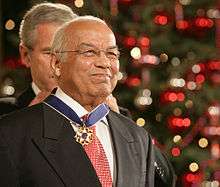 Norman Francis, president of Xavier University of Louisiana, receives Presidential Medal of Freedom, 2006.
Norman Francis, president of Xavier University of Louisiana, receives Presidential Medal of Freedom, 2006.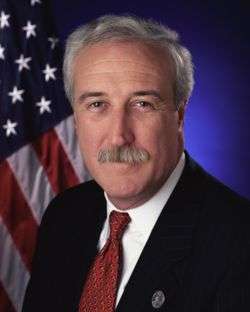 Sean O'Keefe, former Navy Secretary, Louisiana State University chancellor, and National Aeronautics and Space Administration (NASA) administrator
Sean O'Keefe, former Navy Secretary, Louisiana State University chancellor, and National Aeronautics and Space Administration (NASA) administrator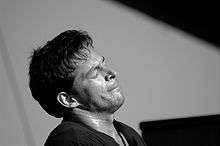 Harry Connick, Jr., musician, actor, and humanitarian.
Harry Connick, Jr., musician, actor, and humanitarian. G-Eazy, musician, producer
G-Eazy, musician, producer
References
- ↑ "NCSE Public Tables Endowment Market Values" (PDF). Retrieved 2012-02-06.
- ↑ "Loyola University New Orleans". Forbes.com. 1970-01-01. Retrieved 2015-05-22.
- ↑ "Loyola University New Orleans Athletics". Wolfpack.loyno.edu. Retrieved 2015-05-22.
- ↑ "America's Best Colleges 2017: Universities-Master's (South): Top Schools". US News and World Report. Retrieved 2008-07-20.
- 1 2 "The Best 371 Colleges". 2010. Retrieved 2010-05-23.
- ↑ Graphic Identity Guide to Loyola, Loyola University New Orleans, April 27, 2010.
- ↑ "French Jesuits, Missions in Louisiana". 2005. Archived from the original on 2007-12-28. Retrieved 2007-06-13.
- ↑ Hawkins, S.J., Donald A. (1987). "The Parish". Church on the Park: Holy Name of Jesus. Laborde Printing Co. p. 12.
- 1 2 Whelan, S.J., James F. (November 1946). "Loyola University, New Orleans". The Southern Association Quarterly. Duke University Press. 10 (4): 538, 540–542. ISSN 0890-7145.
- ↑ "Loyola and WWL Radio celebrate 80th anniversary". 2002. Retrieved 2007-05-04.
- 1 2 "Campus Confidential". 2008. Retrieved 2008-07-24.
- ↑ R. Bentley Anderson (2005). Black, White, and Catholic: New Orleans interracialism, 1947-1956. Vanderbilt University Press. ISBN 978-0-8265-1483-7.
- ↑ History. Accessed 4 June 2016.
- ↑ "Majority of Students to Return in Spring". 2006. Retrieved 2008-07-25.
- ↑ "A Lack of Confidence". 2006. Retrieved 2008-07-24.
- ↑ "Loyola Welcomes Freshmen One Year After Katrina". 2006. Retrieved 2007-05-21.
- ↑ "Loyola's 100th graduating class steps on campus this fall". 2008. Retrieved 2008-07-22.
- ↑ "Freshmen commitments highest since Katrina". 2008. Retrieved 2008-07-25.
- ↑ "Chronology of Loyola's Presidents". loyolamaroon.com. 2004. Retrieved 2007-03-10.
- ↑ "Happy Birthday to Loyola President Emeritus Rev. James Carter, S.J.!". 2008. Retrieved 2008-08-01.
- ↑ "Graphic Identity Guide to Loyola". 2006. Retrieved 2008-01-30.
- ↑ "America's Top Colleges". Forbes. July 5, 2016.
- ↑ "Best Colleges 2017: Regional Universities Rankings". U.S. News & World Report. September 12, 2016.
- ↑ "2016 Rankings - National Universities - Masters". Washington Monthly. Retrieved September 6, 2016.
- ↑ "Loyola University New Orleans | Loyola New Orleans | Best College | US News". Colleges.usnews.rankingsandreviews.com. Retrieved 2015-05-22.
- ↑ "Loyola University featured in 2008 edition of the Princeton Review Annual College Guide – The Best 366 Colleges". 2007. Retrieved 2008-01-30.
- ↑ "What Makes Us Unique?". 2008. Archived from the original on 2007-12-27. Retrieved 2008-01-30.
- ↑ Colleges. Accessed 4 June 2016.
- ↑ Academics. Accessed 4 June 2016.
- ↑ Nursing. Accessed 4 June 2016.
- ↑ Mass Communications. Accessed 4 June 2016.
- ↑ "Loyola University New Orleans | Admissions, Average Test Scores & Tuition". Princetonreview.com. Retrieved 2015-05-22.
- ↑ Business. Accessed 4 June 2016.
- ↑ Music. Accessed 4 June 2016.
- ↑ Law Accessed 4 June 2016.
- ↑ Centers and Institutes. Accessed 4 June 2016.
- ↑ "Loyola History". 2008. Retrieved 2008-07-22.
- ↑ "Loyola History". Loyola University New Orleans. Retrieved 2008-07-23.
The Activities Quad, between Bobet Hall and the Danna Center, was renamed the Plaza De Los Martires De La Paz in 1989 to honor the six Jesuits, their cook, and her daughter who were slain in El Salvador. The Jesuits taught at the University of San Salvador. Eight trees were planted in the Peace Quad as a permanent memorial to these contemporary martyrs.
- ↑ Campus. Accessed 4 June 2016.
- ↑ "Libraries". 2007. Retrieved 2008-07-24.
- 1 2 "Collections + Services". 2008. Retrieved 2008-07-24.
- ↑ "Loyola Featured In Princeton Review's The Best 361 Colleges". 2006. Archived from the original on September 7, 2006. Retrieved 2008-01-30.
- ↑ "Awards + Scholarly Activities". 2008. Retrieved 2008-07-24.
- ↑ "学校紹介" (Archive). Japanese Weekend School of New Orleans. Retrieved on April 6, 2015. "現在、ニューオリンズ日本語補習校の授業は、ロヨラ大学構内で行われています。ロヨラ大学は、アップタウンの閑静な住宅地にあり、勉強するには恵まれた環境です。幼稚部・小学部はモンローホールの5階、中学部はマーケットホールの4階の教室を使っています。"
- ↑ Broadway campus. Accessed 4 June 2016.
- ↑ Law library. Accessed 4 June 2016.
- ↑ "Statement on Environmental Responsibility" (PDF). Loyola University of New Orleans. Retrieved 2009-06-10.
- ↑ "LUCAP: Our Projects". Loyola University of New Orleans. Retrieved 2009-06-10.
- ↑ "Sustainability Garden". Loyola University of New Orleans. Retrieved 2009-06-10.
- ↑ "Danna Student Center renovation update". 2008. Retrieved 2008-07-23.
- ↑ Fox, Julia (September 1997). "Leasing the Ivory Tower at a social justice university". Organization & Environment. Thousand Oaks. 10 (3): 259. doi:10.1177/0921810697103002.
- ↑ Greek life. Accessed 4 June 2016.
- ↑ "ACP Contest Winners". 2006. Retrieved 2008-01-30.
- ↑ "The Maroon Wins National Award". 1998. Retrieved 2008-01-30.
- ↑ "The Maroon Wins National Award". 2015. Retrieved 2015-11-04.
- ↑ Archived September 18, 2010, at the Wayback Machine.
- ↑ Pack News. Accessed June 4 2016.
- ↑ Athletics. Accessed 4 June 2016.
- ↑ "Looking Back: The day the Wolfpack died". 2002. Retrieved 2008-07-23.
- ↑ Pack Pride. Accessed 4 June 2016.
External links
| Wikimedia Commons has media related to Loyola University New Orleans. |
